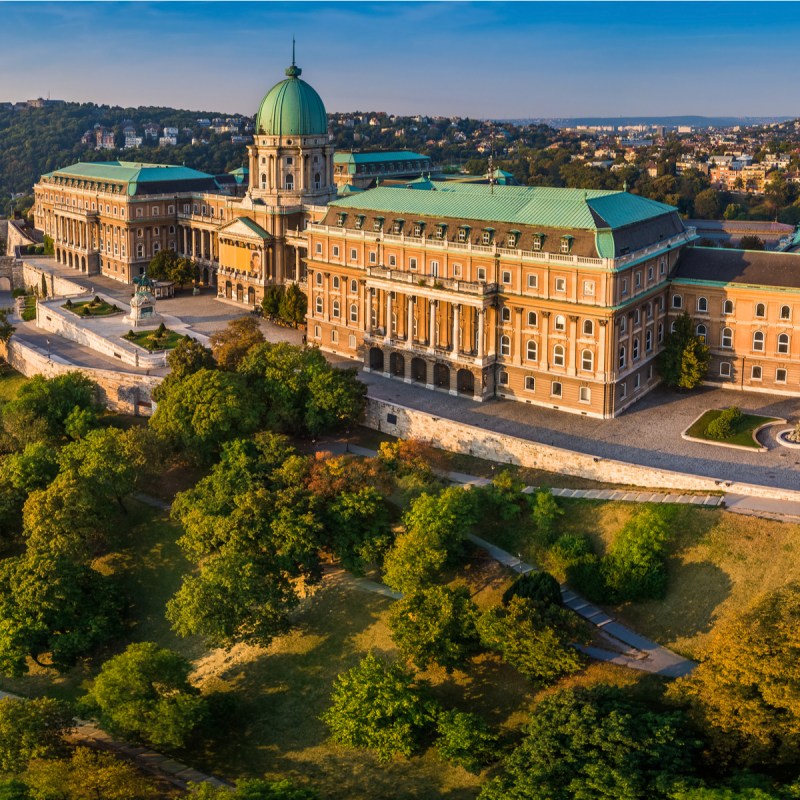
Hungary is a country that is graced with no less than 103 castles, most of them open to visitors. This landlocked Central European country has long been the crossroads of many peoples, becoming the Kingdom of Hungary in A.D. 1000 with its cultural and political height in the 15th century. Then, in the 18th century, it came under Habsburg rule and formed part of the Austrian Empire. The influence of so many peoples and the need to defend against invaders like the Turks and Mongols made it necessary for the rulers of the time to build defensive castles in strategic places.
Videos by TravelAwaits
The Danube and Tisza are the main rivers of Hungary, but the landscape is also defined by the Carpathian Basin, the Great Hungarian Plain, and the vast Lake Balaton. The castles I have selected (and the many I have visited) have been chosen by how well they are preserved, their architectural value, and the often breathtaking locations where they stand. Not all of them were means of defense; others were homes to the respective kings and the aristocracy or just places of pleasure and leisure because of the beautiful landscape that surrounded them or the amazing views.
The capital is Budapest, which is actually the united twin cities of Buda and Pest, separated by the river Danube. Castle Hill with Buda Castle and the royal palace stands in Buda, whilst the romantic Vajdahunyad Castle stands in Pest.
There are five international airports in Hungary, the largest and most served being Ferenc Liszt Airport/Budapest. Apart from taxi services, there are Bud shuttle services as well as buses and trains running into Budapest.

1. Vajdahunyad Castle
This castle is one of the most romantic of Hungary and is also a rarity. Standing on an island in Budapest’s beautiful and green city park, it was, despite its appearance, only built in 1896 in honor of the 1,000 years of the existence of Hungary since the conquest of the Carpathian Basin. The entire complex consists of several buildings in styles reaching from the Middle Ages to the 18th century as it reproduces various historic Hungarian buildings, among them the Baroque Palace of Prince Paul Esterhazy I. Originally, the castle complex was built of cardboard and wood but became so popular that it was decided to rebuild it in stone and brick between 1904 and 1908 to make it a permanent structure. It is accessible over one of four bridges.

2. Buda Castle
Located on the southern tip of Castle Hill, Buda Castle, also known as the Royal Palace, was the historical seat of the Hungarian Kings and was completed in 1265. The castle is surrounded by the castle district with its medieval, baroque, and 19th-century houses. Apart from the beauty of the building itself, which is a UNESCO World Heritage Site, it affords wonderful views over the city and the river and is best appreciated by this 2-hour walking tour. Admire the Lion Courtyard, the Matthias Well, and the statue of Tulu Bird, the mythological bird of the Magyars.
Today, the palace is the seat of the Hungarian National Gallery and other museums.
Pro Tip: Access Castle Hill at night to see everything illuminated, it’s even more magical.

3. Eger Castle
Located 68 miles northeast from Budapest stands one of the most fought about castles of Hungary, Eger Castle. After the invasion by the Mongols in the 13th century, Eger Castle was rebuilt for the first time, repairing the cathedral and bishop’s palace on a hill overlooking the river Eger.
Many sieges and battles followed, most prominently the successful resistance to the siege by the army of the Ottoman Empire in 1552. However, the Turks took the castle in 1596 and held it until they were driven out by Christian forces in 1687. The castle suffered severe damage during all the vicious battles, and today only the medieval bishop’s palace stands, though the casemates below the castle can be visited. To understand the entire history of the castle and the importance of the defeat of the Ottoman Empire, take your time to visit the castle’s Istvan Dobo Museum. There are many more exhibitions and even a wax cabinet to learn all about this castle, so significant for the history of Hungary and Europe as a whole.

4. Visegrad Citadel
We already mentioned that some of Hungary’s magnificent castles are located in spectacular landscapes. Visegard Citadel is one of them. Approximately 40 miles north of Budapest, the citadel was built in 1259 on top of a steep hill and surrounded by moats hewn from solid rock and overlooking the Borzsony Hills and the grand bend in the river Danube. Visegrad was the capital of the kingdom in the 14th century and housed the crown jewels until 1440 when the Holy Crown was stolen by a chambermaid. You can see the whole story behind this event in an exhibition.
Climb the wooden stairs to the top of the citadel not only to enjoy the views of the great river at your feet but also to visit the residential rooms at the west side to get a glimpse of what life and entertainment was like in a medieval royal court in Hungary.
In the summer, the Palace Games are staged. Four days of reenactments, tournaments, archery and falconry that take you straight back in time.

5. Bory Castle
Sometimes referred to as the “Taj Mahal of Hungary,” Bory Castle is a work of art and love, just like its famous Indian namesake. The difference is that the castle’s creator, sculptor and architect Jeno Bory did it all by himself. Here is the story: in 1912 he bought a plot of land and vineyard in the Maria Valley, about an hour southwest from Budapest and near the city of Szekesfehervar, which featured just a wine cellar. He and his wife spent summer holidays there and decided to extend the wine cellar to a holiday home.
From there, beginning in 1923 and over a period of 36 years until his death, Bory expanded the holiday home into a vast castle, all out of love for his wife, painter Ilona Komoscin. His imagination knew no bounds, buildings in the Scottish, Romanesque and Gothic style took shape, every surface was covered with paintings, his own and artist friends’ sculptures adorned the rose garden and the interior of the many rooms.
He did it all by himself with a little help from his students. As a result, this fairy tale structure, for once not a castle dedicated to defending against enemies but just to please the eye as a unique work of art, found its way into the Guinness Book of World Records as the world’s largest building constructed single-handedly. Apart from the garden, there is also an art gallery and a studio and visitors are free to climb the towers and walk around from one marvelous sight to the next.

6. Esztergom Castle And Basilica
Esztergom, in the north of Hungary, was the capital of the country from the 10th to the mid-13th century. In 1543, Esztergom Castle was besieged and finally conquered by the army of the Ottoman Empire. It wasn’t until 1761 that it was reconquered by Christian forces. The bishop then began the construction of a new basilica/cathedral. The Neo Classical-style building became the largest Roman Catholic building in Hungary. Inside, you can admire the world’s largest altarpiece, painted on one canvas by Grigoletto. There is also an organ to listen to which at the time of its construction, 1856, was the largest in Hungary. As you can see, Esztergom Castle and Basilica is a place of several superlatives.
Pro Tip: You can get to Esztergom from Budapest by train or bus in around 1.5 to 2 hours.

7. Diosgyor Castle
Diosgyor Castle is located on a rocky hill above the valley of the Szinva stream near the northern Hungarian town of Miskolc. It was a castle at the time of the Mogul invasion in the 12th century but was destroyed. After that it was rebuilt in a much more impressive fashion with moats and four massive corner towers and had its peak in the 14th century as a seat for the kings and their favorite hunting ground because of the nearby forest that was full of deer and boar. Later, the castle became a wedding gift for the queens of Hungary; in fact, it was owned by six of them.
The Ottoman invasion in the 16th century left the castle in ruins and it remained very much in that dilapidated state until excavations began in the 1960s when the castle was restored and reopened in its former glory in 2014. The state rooms are furnished with medieval-style furniture, and a great attraction is the wax work exhibition which reproduces six scenes of medieval life in the castle.
Twice yearly, games are held with jousting tournaments, open air plays, and a medieval market nearby. The spring that was used to fill the moat is now used to fill a nearby public swimming pool.
In the outer castle there is another popular tourist attraction: a small mint where visitors can make their own memorial coins.

